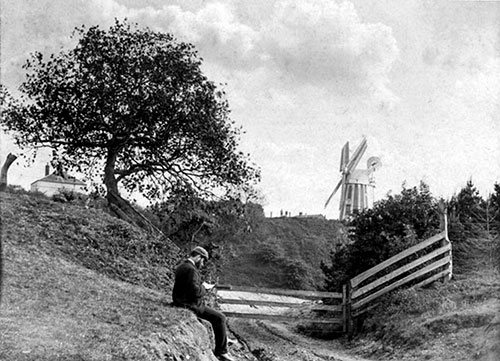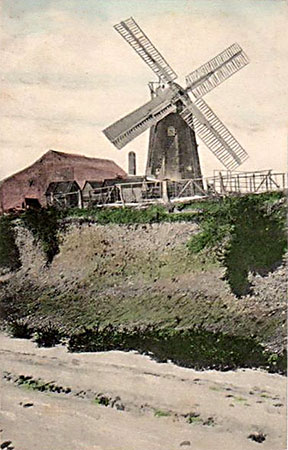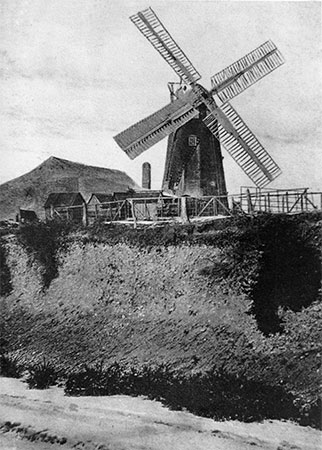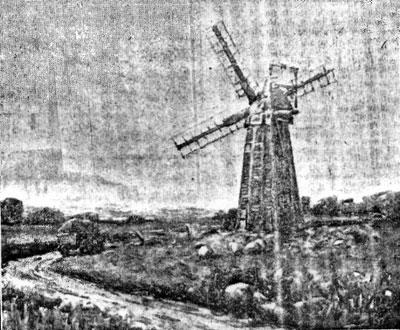
|
Strumpshaw
smockmill |
 |
|
c.1900
|
Strumpshaw smockmill stood on a hill to the south of the village. The 10 sided mill had a Norfolk boat shaped cap with a straight ridge that held a chain pole. Power to the machinery was supplied by 4 double shuttered sails, each with 8 bays of 3 shutters and 1 bay of 2 shutters. |
A violent storm of wind and rain, such as had not been remembered since 1741. Happisburgh, Postwick and Strumpshaw windmills were blown down ... |
There is a remarkable Windmill in this town supposed to stand upon the highest ground in Norfolk; it is seen at a vast distance and overlooks most of the neighbouring hundreds; from it Yarmouth and Lowestoft in Suffolk are easily distinguished and it has full command of the city of Norwich, not being distant above seven miles. Being situated near Buckenham Ferry, there is a delightful view of the river Yare meandering through the country till it falls into Breydon Broad near Yarmouth. The prospect from this windmill is the finest COUP D'OEIL in the county of Norfolk and the mill itself when the sails are going is a beautiful object as far as it can be seen. |
At this place is a remarkable Windmill supposed to stand on the highest ground in the county; for hence Yarmouth and Lowestoffe on the coast of Suffolk are easily distinguishable and it commands a full view over the adjacent hundreds and the city of Norwich and the meanderings of the river till it falls into Braydon Broad. The prospect from this eminence is justly esteemed the finest coup d'oeil in Norfolk; and the windmill, when the sails are going forms a conspicuous landmark to distant parts of the county. |
 |
 |
|
c.1905 |
|
To be Let |
Situations Vacant |
Frederick William Kemp was born in 1841 and was master miller at Elsing_watermill when he married in 1868. He ran Witton_(Blofield_postmill from 1879 - 1879, then Croxton_postmill and towermill from 1883 - 1890 and was at Strumpshaw smockmill in 1896. |
Smithdale's Day Book 1882 |
||||||||||||||||||||||||||||||||||||||||||||||||||||||||||||||||||||||||||||||||||||
|
||||||||||||||||||||||||||||||||||||||||||||||||||||||||||||||||||||||||||||||||||||
 |
|
c.1916 |
The smock mill was demolished in 1916 having closed in 1908. It was left, unstable, on a pinnacle of high ground while the surrounding area of some 30 acres was quarried for sand and gravel. The pit was worked to extinction by 1973, including the mill site, and the whole area became a NCC landfill site. |
Henry Burstal of Loddon in his will also left to wife Maria |
Emanuel Bowen's map of 1749 showed a total of 8 corn mills: Briningham postmill, |
| Emanuel Bowen's map 1749: Windmill (along with 7 other mills) 19th December 1770: Mill blown down along with mills at Happisburgh and Postwick Armstrong's History of Norfolk 1781: Strumpshaw Mill Faden's map 1797: Strumpshaw windmill Poll Book 1806: Edward Smith, miller Bryant's map 1826: Windmill January 1827: Mill advertised to be let Greenwood's map 1834: Windmill White's 1836: Thomas Welch & Son, cornmillers & c. Index of Will 1840: Thomas Welch, miller
White's 1845: George Welch, cornmiller & c.
1853: John Chapman, miller & merchant White's 1854: John Chapman, miller 1858: John Chapman, miller & merchant
1863: William Greenacre, miller White's 1864: William Greenacre, corn miller 1865: Samuel Greenacre, miller 1868: William Grapes, miller
1875: Richard Knight, miller 1878: Richard Knight, miller Kelly's 1879: Richard Knight, miller
White's 1883: William Littleproud, miller, baker & beer retailer 1888: Frederick Johnson Goff, miller White's 1890: Frederick Goff, miller & baker
Kelly's 1892: Frederick Johnson Goff, miller (wind) Kelly's 1896: Frederick William Kemp, miller (wind & steam) - left Ovington Old postmill in 1892 1899: James Arthur Aldous, owner, died in Beccles Kelly's 1900: Frank Neave, farmer & miller (wind & steam)
Kelly's 1904: Frank Neave, miller (wind & steam) Kelly's 1908: Frank Neave, miller (wind & steam) 1908: Mill ceased working O.S. map 1910: Windmill 1916: Mill 'pulled down' 1926: Mill derelict 1949: Mill demolished 1973: Gravel pit of 30 acres under mill site finally worked out 1980: Mill site Norfolk County Council landfill refuse dump |
If you have any memories, anecdotes or photos please let us know and we may be able to use them to update the site. By all means telephone 07836 675369 or
|
| Nat Grid Ref. TG35360727 |
Copyright © Jonathan Neville 2009 |